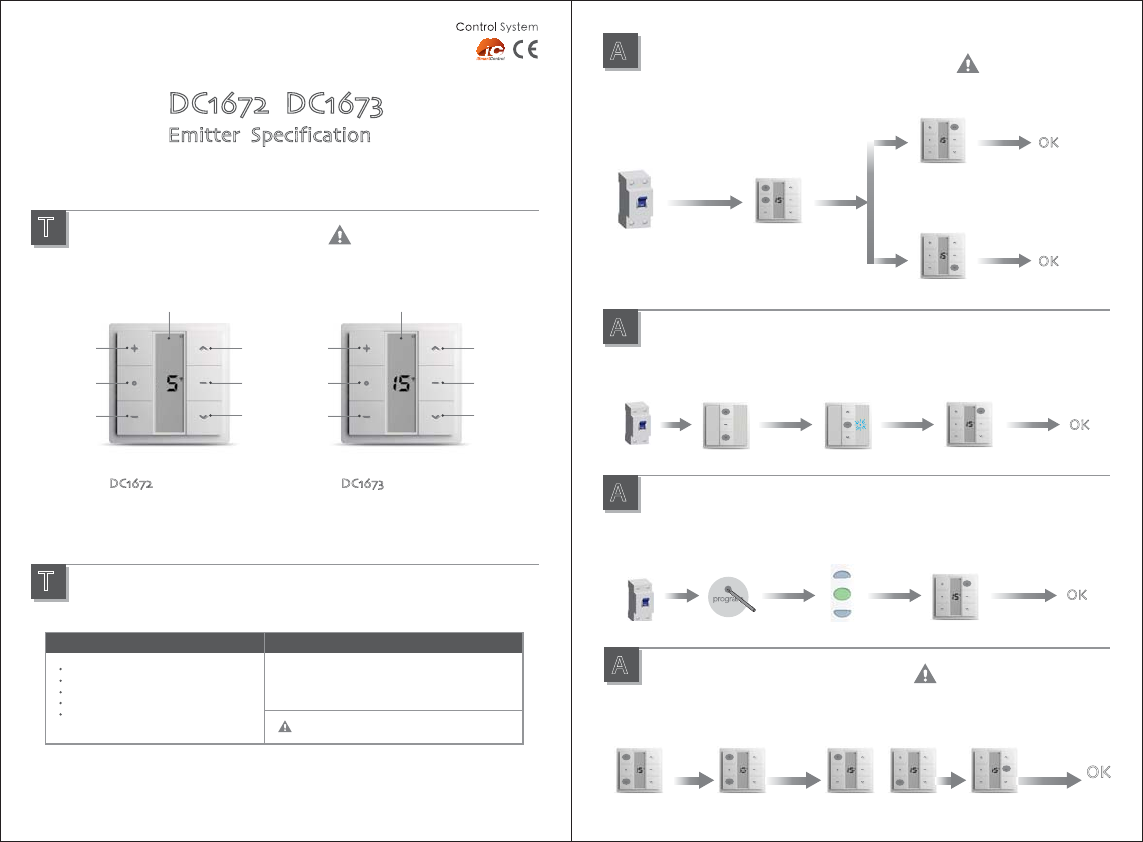NINGBO DOOYA MECHANIC and ELECTRONIC TECHNOLOGY DC1673 Emitter User Manual eDC1672DC1673 A 01
NINGBO DOOYA MECHANIC & ELECTRONIC TECHNOLOGY CO., LTD. Emitter eDC1672DC1673 A 01
User Manual

Emitter Specification
Type specification
Technical support
Version NO. : A/02
Fucntion instructionTechnical specification
Input voltage碋3V(CR2430)
Transmitting frequency碋433MHz
Transmitting power碋10 milliwatt
Operating temperature碋-50C—500C
Transmssion distance碋200 meters open office硽
35 meters on two walls
Transmitter: five channels (DC1672), fifteen channels (DC1673). One number
of LCD screen means one control channel. Press “channel choose” button P1-
(number descending) or P1+ (number increasing) to change the channel. On
the analogy of this, loose finger when the indicator light move to suitable
channel that you select effective channel. If LCD screen number show “0”
that means all channels if effective (group control state).
Notice: transmitter do not exposed to moisture and strike, so as not to affect life.
When you use transmitter, if found emission distance obviously short or less sensitive,
please change another same new battery. Please have batteries for recycling.
DC1672 DC1673
A
Additional
function
Matchable R tubular motor set up
During the settings, the time between two operation
must be shorter than 4s, otherwise it will quit the setting
During the settings, the time between two operation
must be shorter than 6s, otherwise it will quit the setting
During the settings, the time between two operation
must be shorter than 10s, otherwise it will quit the setting
A
Additional
function
Matchable DC1680 / DC1681 set up
A
Additional
function
Matchable DC136 set up
Power on
Setting
is ok
OK
P2×1
See indicator
flashing
See green in-
dicator flashing
and extinguished
See indicator
long flashing
EmitterReceiverReceiver
Stop button×1 Up button×1
Up button ×1
Down button ×1
OK
OK
Power on
Hear long sound Hear di di...
Setting is ok.
The up button control
the motor clockwise
Setting is ok.
The down button control
the motor clockwise
Sound tip
three times
Sound tip
three times
Power on EmitterReceiverReceiver
See indicator
flashing
Setting
is ok
OK
See indicator
flashing
See indicator
long flashing
(Up button +Down button)×2s Stop button×1 Up button×1
Up
button
Stop
button
Down
button
LCD screen
DC1673
15 - channel LCD emitter
P1-
button
P1+
button
Up
button
Stop
button
Down
button
LCD screen
DC1672
5 - channel LCD emitter
P1-
button
P1+
button
T
Technical
support
T
Technical
support
After matching code for new emitter,
it will clear all the data in the motor
Reserved
button
Reserved
button
Setting button=P1+ button +Reserved button
(P1+button +Reserved button)×2
Setting
is ok
Stop×1
(P1+button+
P1-button)×1
P1+button+P1-
button,hold on
A
Additional
function
The valid channels selection
In the setting state,press the up or down
button you can quit quickly, if you want
to change the valid channels ,reset it.
The screen
will display o
Press P1+button or P1-button,
selecting the channel (channe l
1 to channel 15) you need
OK
The screen
will display 15
The screen
will display C Or
FCC STATEMENT
1. This device complies with Part 15 of the FCC Rules. Operation is subject to the following two
conditions:
(1) This device may not cause harmful interference.
(2) This device must accept any interference received, including interference that may cause
undesired operation.
2. Changes or modifications not expressly approved by the party responsible for compliance could
void the user's authority to operate the equipment.
NOTE: This equipment has been tested and found to comply with the limits for a Class B digital
device, pursuant to Part 15 of the FCC Rules. These limits are designed to provide reasonable
protection against harmful interference in a residential installation.
This equipment generates uses and can radiate radio frequency energy and, if not installed and
used in accordance with the instructions, may cause harmful interference to radio communications.
However, there is no guarantee that interference will not occur in a particular installation. If this
equipment does cause harmful interference to radio or television reception, which can be
determined by turning the equipment off and on, the user is encouraged to try to correct the
interference by one or more of the following measures:
ǂ Reorient or relocate the receiving antenna.
ǂ Increase the separation between the equipment and receiver.
ǂ Connect the equipment into an outlet on a circuit different from that to which the receiver is
connected.
ǂ Consult the dealer or an experienced radio/TV technician for help.